Mediterranean south bank
So i have written about Europe being the mediterranean northern bank on this blog before. When i flew to South Africa last week i actually had a chance to have a look at the Mediterranean south bank for the first time:
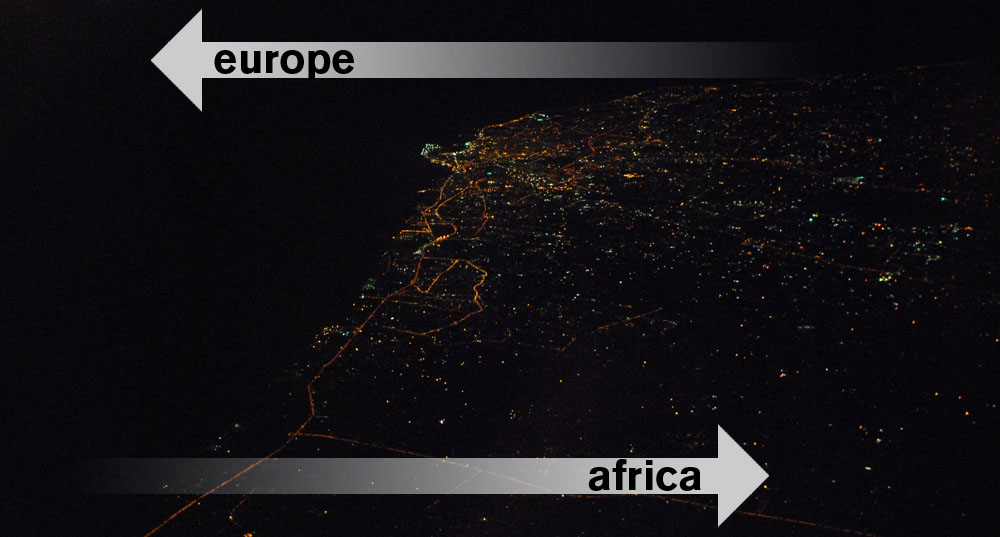
So i have written about Europe being the mediterranean northern bank on this blog before. When i flew to South Africa last week i actually had a chance to have a look at the Mediterranean south bank for the first time:

So 2007 is coming to an end and it is time to draw up the balance. when it comes to migrants who have died trying to reach Europe, 2007 has been an exceptional bad year even though the powers that be seem to think otherwise. Back in august the IHT quoted spanish and italian officials that proudly proclaimed that the number of arrivals at their shores had been down from the numbers for the same period in 2007:
The deadly flow of flimsy boats crammed with migrants heading north across the Mediterranean has slowed substantially this summer. After years of surging arrivals, Italy and Spain, the initial destinations for thousands fleeing Africa for safety or jobs in Europe, are reporting drops of a third or more compared with last year.
Government officials in both countries trumpet success from more sea-borne patrols and better cooperation with African nations across the Mediterranean to reduce journeys that have seen often-unwanted migrants wash up in Europe and claimed thousands of lives in the past decade, experts estimate.
But even as Spain is reporting a sizable decrease in drownings, success is far from complete. With more obstacles in place, migrants appear to be taking greater risks. Fortress Europe, a migrant advocacy group, reports that the number of deaths among those seeking to reach Italy has remained stable, despite the drop this year in overall arrivals, suggesting that those who try face a more perilous journey.
Looking at my own figures i can only second this impression given by Gabriele del Grande. 2007 has been worse both in terms of incidents (55 in 2006 compared to 90 in 2007) and the number of victims of the European border regime (653 persons have died trying to reach europe in 2006. 2007 has already cost 730 lives). Of course these numbers do not represent the real tragedies that are taking place as they are derived from those incidents that are reported in the international press and as they only count those who are confirmed to have died (the numbers would quadruple if they would include all those reported to be missing).
While i have seen no year-ed figures for the number of arrivals it seems safe to say that spending money on stupid joint operations and videos aimed at scaring people away does not exactly work as intended. Neither does it keep people from coming to Europe nor does it keep them from dying while trying.
Update 26-12-2007: There is an excellent article (in German) about the same topic and specifically about the questionable role of frontex available on telepolis.
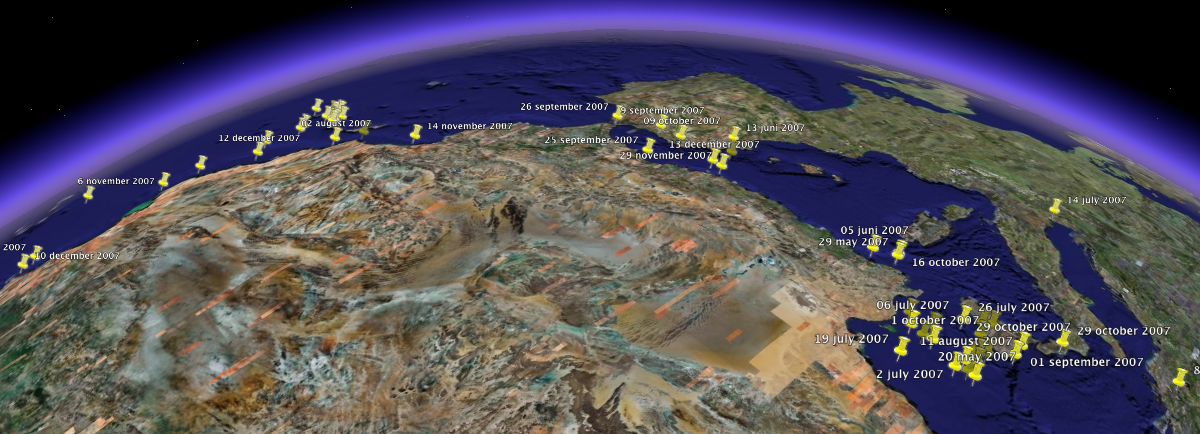 Deadly incidents in the western mediterranean/atlantic in 2007
Deadly incidents in the western mediterranean/atlantic in 2007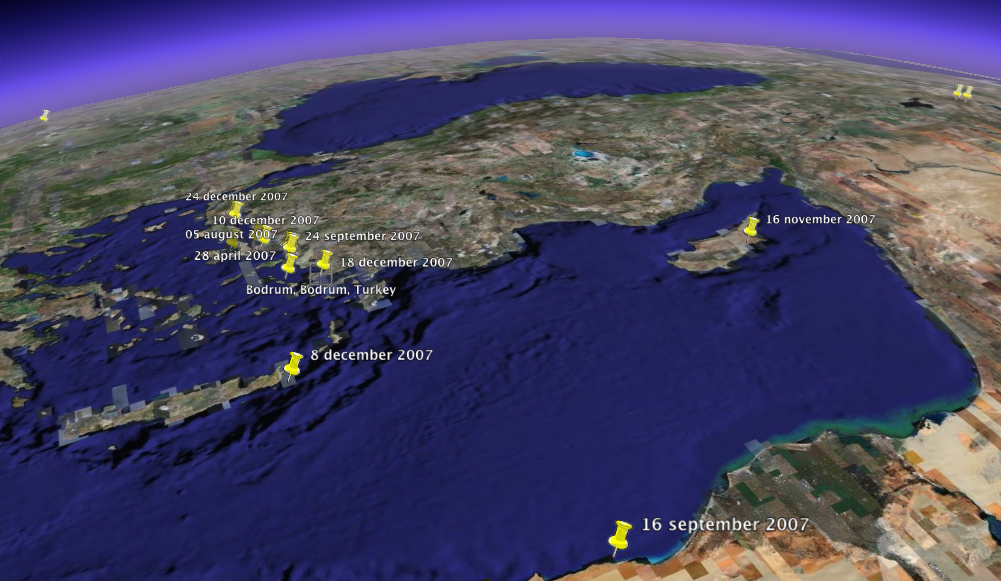 Deadly incidents in the Eastern mediterranean in 2007
Deadly incidents in the Eastern mediterranean in 2007
Just finished reading a fairly intresting reserach paper by Hein de Haas of the International Migration Institute in Oxford that deals with the ‘The myth of invasion – Irregular migration from West Africa to the Maghreb and the European Union‘. In the paper de Haas attempts to show that immigration to Europe by western African migrants crossing the Mediteranian or Atlantic is fairly small both when compared to migration of western africans to North African Countries and compared to other ways of gaining access to the EU (mostly by overstaying visa).
While this is probably a fairly realistic conclusion when it comes to the relative numbers, his estimations concerening the absolute numbers (25.000 successful crossings per year) are fairly unconvincing: there is almost no reliable empirical data on undocumented border crossings available and that does not get much better by ‘triangulating’ a bunch of unreliable data sources. Still the paper makes a fine antidote to ramblings about hordes of african would-be terrorist immigrants who are waiting in Africa planning organized assaults on our coasts.
For those to lazy to read the 83 page paper, here are two extracts from the conclusion:
This study showed that apocalyptic representations of a massive exodus of desperate Africans who are pushed out of the continent by poverty, war and drought are fundamentally flawed. The popular perception that irregular migration from Africa is growing at an alarming rate is deceptive. Since the introduction of visa requirements for North African countries by Italy and Spain in the early 1990s, illegal crossings of the Mediterranean Sea have been a persistent phenomenon. Rather than an increase per se, the major change has been that, after 2000, sub-Saharan Africans started to join and have now overtaken North Africans as the largest category of irregular boat migrants. Although almost all West African countries are represented in these flows, most migrants tend to come from a relatively small number of countries, in particular Senegal, Mali, Ghana and Nigeria. It is a myth that all West African migrants crossing the Sahara to North Africa are ‘in transit’ to Europe. There are probably still more sub-Saharan Africans living in North Africa than in Europe. Libya in particular is an important destination country in its own right, in particular for Chadians, Nigeriens and Sudanese. Other North African countries house smaller but growing West and Central African communities. […]
The common portrayal of irregular African migrants as “desperate” and impoverished victims of “unscrupulous” traffickers and “merciless” criminal-run smuggling networks is inconsistent with empirical evidence that the vast majority of migrants move on their own initiative. Migration is generally a conscious choice and often a family investment rather than a desperate move. Migrants are generally not among the poorest and least educated of their origin communities. Smugglers are usually not part of international organised crime, but tend to be locally based and operate alone or in relatively small, flexible networks. Migrants travel in stages and typically pay smugglers for one difficult leg of the journey.
Bonus: the cover of page of the study shows a photo of a fragment from a painting hanging in a restaurant in Dakar showing a number of wooden Cayucos which are commonly used for the voyage to the Canary Islands. One of the boats is named ‘Barsaa ou barsaqq’, which according to de Haas means ‘Barcelona or hell’ (according to this earlier story in the Guardian it translates to ‘Barcelona or afterlife’, but given that Egypt’s top religious advisor has just issued a fatwathat muslims who die attempting to reach Europe can not be considered to be martyrs, hell might indeed be a more precise location (at least when it comes to muslims)).
See also this video for more Barsaa/Barsaqq statements (and somebody needs to tell de Haas that the boats are called Cayucos and not Pirogues).
So over the last three weeks i have been watching ‘kaafila‘ which bills itself as a movie based on the ‘global issue of illegal migration’. It took me 3 weeks to watch because (a) it is a Bollywood movie (and thus runs for three plus hours) and (b) because it is so incredibly bad that i could not muster the courage to watch bits that were longer than 15 minutes. Matter of fact it is so bad that that the songs (those ridiculous dancing/singing scenes that are required to interrupt Bollywood productions every so often) were more bearable than the ‘story’ itself.
So why did i buy it in the first place then? Kaafila contains a scene that depicts what has become to be known as the ‘Malta boat tragedy‘: the sinking – off the coast of the Sicilian town of Portapalo on December 26th 1996 – of a ship carrying more than 300 south-east asian migrants bound for Italy. More than 280 migrants lost their lives in this disaster (the worst post WWII maritime accident in the Mediterranean) and i was curious how this would be portrayed in a feature film made in one of the countries where a large part of the victims was hailing from. Plus some of the reviews actually did sound quite intriguing:
… in their effort to forge ahead closer to their dream, the innocent dozen finds itself trapped sometimes by the Russian mafia involved in the plutonium smuggling racket and sometimes by the militancy on the Afghan borders. Here they meet an Afghani girl…
Now as i said the movie is exceptionally bad. The story is erratic at best, the characters depicted are extremely unrealistic (although the opening credits of the film actually try to make a somewhat realistic introduction into the migrants’ motives for seeking their luck elsewhere) and, on top of this, the trajectory of the journey defies any logic at all:
From India our group of migrants is first flown to Moscow where they are held captive by a Pakistani trafficker for 5 months. He finally takes them across the border to Ukraine (shooting one of them on the way) but decides to take them back to Russia after one of them lights a fire at night, which, according to the trafficker, will alert the border guards and guarantee the group’s arrest.
On the way back another of the migrants freezes to death under fake styrofoam snow while hiding from a helicopter. Back in Russia the group heads towards the Black sea coast where they board a ship that is supposed to take them to Malta. In real life this would mean crossing the Black sea, sailing through the Bosporus, crossing the Aegean sea, sailing around Apulia to continue to Malta (or to be more exact Sicily where the real ‘Malta boat tragedy’ took place). In Kaalifa our heroes board the boat and immediately burst into another dancing scene to the films theme song ‘Chala Kaafila’, a strange mix between eurotrash and hindi film music:
Chala Kaafila is a outcome of a confused state of mind. With music lingering somewhere between the genres of folk and club mix, Chala Kaafila boasts of a strong blend of North Indian music with unnecessary westernized musical goof ups. [from: RS Bollywood Online music reviews]
The song opens with the singer (the only female on board who somehow disappears before the ship goes down) shouting ‘i don’t want to wait no more let’s bring the house down’ over extremely annoying house beats. this is followed by mad dancing of the assembled 300 migrants on the deck of the doomed ship and once the song ends the ship’s passengers become aware of a giant wave (clearly inspired by the 2004 asian tsunami, which coincidentally also happened on a 26th of December) slowly approaching and jump ship in fear.
For some reason (supposedly because they cling to pieces of wood taken from the ship before jumping into the sea) our 10 remaining heroes are the only ones to survive and wash up on a beach (which turns out to be the Russian Black sea coast again). here our heroes meet the wife of an mad Indian nuclear engineer who is selling liquid plutonium to the Taliban (with the help of the Russian mafia). For rather unclear reasons the wife is shot dead by the Mafia and in this moment, out of nowhere, the above-mentioned Afghani girl appears, secures the liquid plutonium, a bag of giant diamonds and offers our heros a lift to Kazaksthan.
From here on the ‘innocent dozen’ comes under the protection of a dubious Pakistani I.S.I agent who teams up with the Afghani girl to fend off waves of waves of Russian mafia killers and Taliban fighters attempting to kill our heros while they cross Tadzhikistan and Afghanistan heading towards Pakistan (along the way various attempts to put them on a plane to Europe fail). En route 4 more of them are being killed despite the incredible marksmanship of the Pakistani agent and the Afghani girl, who kill dozens after dozens of the attackers.
Finally, in Pakistan the I.S.I agent somehow reconciles with his superiors (in one scene he seems to be talking to Pervez Musharraf himself) who had been pissed off with him for another unclear reason (there are hints that he was suspected to be involved in some Abdul Qadeer Khan style nuclear smuggling operation) and arranges for our heroes’ safe passage across the border to India. in the final scene the 6 remaining migrants plus the Afghani girl can be seen walking to back towards an imagined India, now being completely cured of their initial desire to leave mother India and find their luck in England…
Even if i was willing to accept that Malta is an island located in the Black sea, that the Taliban ‘look like Indians wearing fake beards‘ who can’t shoot straight and that liquid plutonium can be handled safely in open containers, this still is the worst movie i have ever seen (with the mask being a close second). Here are some screen shots of the malta boat tragedy dance:
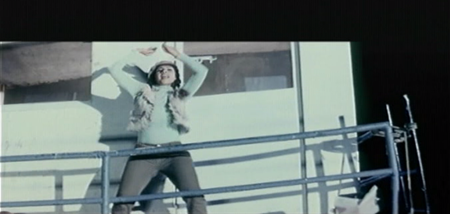
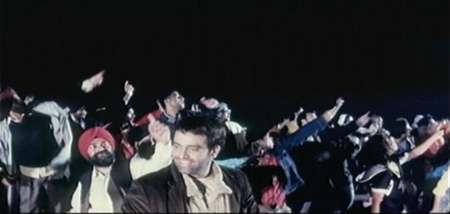
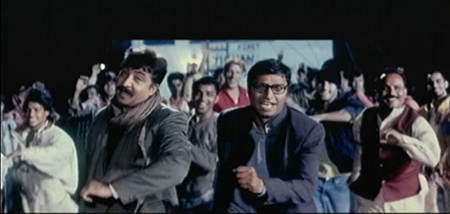
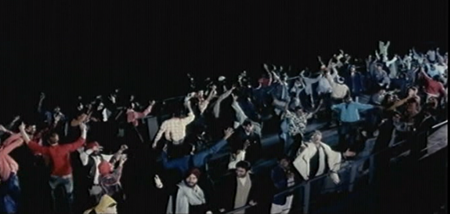
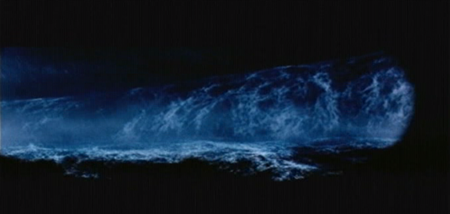
Apparently someone at the BBC has tracked down some of the migrants who got rescued after hanging on to a tuna fishing net for three days in the Mediterranean back in may. They will be featured in the documentary ‘Destination Europe‘ which airs tonight at 2030 on BBC one. There is another article based on interviews with five of the migrants available on the guardian website.
So the Italians and the Spanish are claiming that this year there are much less immigrants trying to enter Europe via their shores, islands and outposts on the african mainland than last year. while this may be true this does neither mean that less people are dying on the Atlantic or in the Mediterranean while trying to get to Europe nor is it something that these governments should be particularly proud of. Looks like the italian authorities have just managed find themselves another way of ‘protecting’ europe form the ‘influx’ of African migrants:
Project meltingpot reports (in italian) that the authorities in Lampedusa arrested seven tunisian sailors for saving immigrants from drowning at sea. In case you can’t read italian (neither can i) the Maltese independent has a shorter article available in english:
On 8 August, seven Tunisian fishermen were arrested at Lampedusa and charged with having saved the lives of 44 migrants from rough seas 40 miles south of Lampedusa. The seven have been charged with having helped illegal immigrant trafficking, the same charge that was to be made against Raymond Bugeja. The seven are the two captains of two fishing boats from Monastir and their five-man crew.
The immigrants that included 11 women and two children had launched an SOS on a satellite phone.
While the Italian agency ADN Kronos claimed the two fishing vessels were the much discussed ‘mother ships’ which are said to bring the illegal immigrants to just below the horizon of either Malta or Lampedusa and from there launch the small boats the asylum seekers come in, other Italian sources dispute this: they argue the two fishing vessels were easily identifiable as being mother ships. Besides, no trace of any small boat was found. It also seems there were some language difficulties as the Tunisian ships entered Italian waters when they had been ordered to stay out.
The end result was that the seven were arrested and kept in prison and their boats seized by the Agrigento authorities, the simple reason being that they had just helped people who were drowning.
update (30.aug.07): There is an much more detailed english article on the fortress europe blog.
Oh, and do read the IHT article linked at the beginning. it contains some of the worst rhetoric i have come across in a long time:
They are perhaps the most stark component of a quandary Europe has had much trouble solving: how to continue to meet its international obligation to protect those fleeing war and persecution while keeping out those it fears will form a permanent underclass or, in the worst cases, expose their countries to terrorism.
Guess that is why they stick ‘security checked’ stickers on cruise ship passengers disembarking in Amsterdam to head for the coffee shops…
For some reason have kept a google news alert for this article in my inbox over the last week:
18 clandestine migrants were saved from a shipwreck, by Algeria II passenger-ship. A well-informed source told El Khabar that the clandestine migrants were attempting to reach the Mediterranean northern bank. They were handed over Tuesday to Oran port coast guard services.
Algeria II passenger-ship discovered, during its Oran-Marseille trip last Sunday, 8 people on the point to sink as their boats could not resist the strong waves movements. The ship crew saved them and decided to continue the trip toward Marseille for it was impossible to cancel it. On the way back, the same ship discovered at large another sinking boat with 10 clandestine migrants on board. They were 18 “haragas” [pk: those who ‘skim’ across the sea, the forbidden ones, to attempt the adventure of emigration] and aged lesser than 30. El Khabar sources denied any lost or dead among them.
Not sure what exactly what intrigued me about this article so much to not delete it. might be the slightly clumsy use of english which no doubt is the the result of either french to english or arabic to english translation. in any case i really like they way europe is referred to as the ‘mediterranean northern bank’ (if you are to believe google nobody but the writer/translator of the article in question and the ‘Standing Committee for the Euro-Mediterranean Partnerships of the Local and Regional Authorities‘ use this description. if you ask me, it should definitely be used more often! sounds like Europe is separated from Africa by a tiny little river called the Mediterranean:
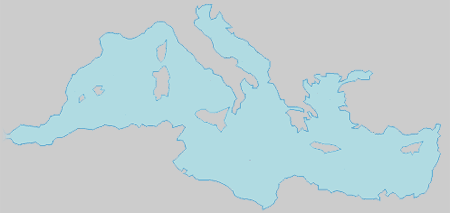
The ECF has put the report online which i wrote about the euro Mediterranean reflection group meting in Amman in june (yes the one that killed my last macbook). It is called between ‘a rock and a hard place’ and deals with the issues of artistic practice and international collaboration in the Middle East. Get the pdf from the ECF website (More on the activities of the Mediterranean reflection group of the ECF can be found here).
Summer is approaching and that means a seasonal increase in African migrants who try to reach Lampedusa, Sicily or Malta from the coasts of Libya and Tunisia. As in the last couple of years lots of them manage to reach these island outposts that have come to be the most accessible edges of the European Union and lots of them don’t. An sometimes people are deliberately left hanging in between these two options for a while:

Over the weekend 27 migrants spent a day at sea holding on to buoys around a giant tuna net attached to a maltese tow-boat. the captain of the tow-boat had saved them from the waters off the Libyan coast after their boat had sunk. They had to stay there for more than 24 hours because the owners of the tow-boat where afraid to let them aboard in order not to jeopardize the 1 million euro worth of tuna in the net as both the maltese and the Libyan authorities refused to save them from the seas. After 24 hours the Italian authorities intervened and transferred them to an Italian navy vessel (more in this times online article).
The whole thing reminds me of the fact that Moritz has some really amazing pictures of sicilian tuna fishers online. Well worth checking out…
Since December 2002 i have been collecting press reports about migrants who have died trying to reach Europe for the noborder website. At the time of writing this the list has grown to 179 incidents with a total of 2009 reported fatalities and an even higher number of people missing who most likely have died as well. It is also safe to assume that the majority of such cases never gets reported in the press at all (according to spanish immigration officials about 6000 African migrants have died or gone missing on the sea journey to the Canary Islands in 2006 alone).
Over the last couple of days i have taken the data i have collected and mapped it onto google earth to get visual representation of the geographic distribution of these incidents. If you have google earth installed (it is a free download from google) you can download the .kml file here (right click to download) and have a look at the data yourself.
The visual representation of the data clearly shows that most migrants perish at sea. there are 4 big clusters of incidents:
One along the west coast of Turkey (mainly boats attempting to reach the Greek islands of Lesvos, Chios and Samos from the region around Izmir). The second cluster is along the route from Libya and Tunisia to Sicily, Lampedusa & Malta (the data for 2005 actually looks like a straight line from Libya to Sicily). The third cluster is around the strait of Gibraltar and the last cluster of drownings can be found along the West African coastline (boats from southern Morocco, Mauritania & Senegal attempting to reach the Spanish Canary Islands.
This last route has become especially popular (and deadly) in 2006: in 2003 5 incidents were reported around the Canary Islands, in 2004 there were 7, in 2005 9 and in 2006 the number soared to 23 reported incidents. This increase is commonly attributed to the fact that straight of Gibraltar and the Moroccan coast have become more heavily policed by European and Moroccan police and military forces so that sub-saharan migrants are forced to find alternative routes to Europe. One of these routes is the up to 1500 kilometer long voyage across the open Atlantic ocean from Mauritania and Senegal to the Canary islands which are part of the EU. The increase of deadly ship wrecks is clearly illustrated by these two screenshots showing the incidents from 2005 and 2006 respectively:
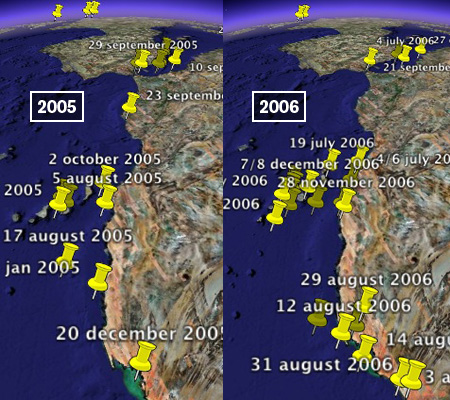
At the same time the number of incidents in the strait of Gibraltar seems to be pretty stable at a low level, which probably does not mean that this route is still as widely used as it once was, but that it used to be a relatively safe route (no wonder give that the distance to travel is 100 times shorter) and that people are forced to take more risks here as well.
There is an excellent background article on ‘Trans-Saharan Migration to North Africa and the EU’ on the migration information source (published by the migratiion policy institute in the US) which confirms the above observations but also points out that for many sub-saharan migrants crossing the Mediteranian or the Atlantic is hardly the most dangerous part of their voyages:
The risks of crossing the Sahara are believed to be higher than crossing the Mediterranean or the Atlantic. In response to increased restrictions in North Africa, border and police officials tend to charge higher bribes, and migrants increasingly use secondary, often more dangerous routes through the desert.
Away from the seas migrants attempting to reach the EU also die in the minefields along the Greek Turkish border, get shot attempting to overcome the fences separating the Spanish exclaves of Melilla end Ceuta from the Moroccan mainland, freeze to death at the Ukrainian Slovakian border, get crushed by trucks on both sides of the English Channel and every now and then a dead migrant or two are found in the undercarriage of an airplane at one of the mayor european airports (sometimes also as far away as Los Angeles)
meanwhile... is the personal weblog of Paul Keller. I am currently policy director at Open Future and President of the COMMUNIA Association for the Public Domain. This weblog is largely inactive but contains an archive of posts (mixing both work and personal) going back to 2005.
I also maintain a collection of cards from African mediums (which is the reason for the domain name), a collection of photos on flickr and a website collecting my professional writings and appearances.
Other things that i have made online: